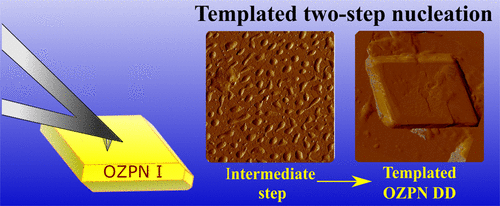当前位置:
X-MOL 学术
›
Cryst. Growth Des.
›
论文详情
Our official English website, www.x-mol.net, welcomes your feedback! (Note: you will need to create a separate account there.)
Direct Observation of Templated Two-Step Nucleation Mechanism during Olanzapine Hydrate Formation
Crystal Growth & Design ( IF 3.8 ) Pub Date : 2017-11-07 00:00:00 , DOI: 10.1021/acs.cgd.7b01060 Monika Warzecha 1 , Rui Guo 2 , Rajni M. Bhardwaj 3 , Susan M. Reutzel-Edens 3 , Sarah L. Price 2 , Dimitrios A. Lamprou 4 , Alastair J. Florence 1, 5
Crystal Growth & Design ( IF 3.8 ) Pub Date : 2017-11-07 00:00:00 , DOI: 10.1021/acs.cgd.7b01060 Monika Warzecha 1 , Rui Guo 2 , Rajni M. Bhardwaj 3 , Susan M. Reutzel-Edens 3 , Sarah L. Price 2 , Dimitrios A. Lamprou 4 , Alastair J. Florence 1, 5
Affiliation

|
Investigating crystal nucleation at the nanoscale is of significant interest, in particular, as more complex, nonclassical routes have roused questions about the classical view of homo- and heteronucleation processes. Here, we report the direct observation of a two-step nucleation mechanism during the transformation of anhydrous olanzapine to olanzapine dihydrate. Atomic force microscopy studies of the dominant (100)OZPNI face of olanzapine form I single crystals in contact with water show the formation and growth of dense nanodroplets concentrated at the steps. In unstirred solution, apparent ordering and crystallization from these droplets occur with olanzapine dihydrate D produced by the templating effect of the underlying olanzapine I lattice. In contrast, under stirred conditions a kinetic dihydrate polymorph, dihydrate B, nucleates probably due to the detachment of nanodroplets from the surface during stirring and a consequent loss of template effect. Computational modeling of the binding of olanzapine growth units on crystal step reveals many strongly bound dimer positions unrelated to either crystal structure. This impedes surface integration and contributes to the growth of disordered clusters at the ledge site. Nanocrystal modeling shows that the (100)OZPNI surface favors the nucleation of dihydrate D over the kinetic form. This work gives an important insight into heterogeneous two-step nucleation where the first step, the formation of a prenucleation droplet, can in the second step, bifurcate, either to produce the stable form by templating, or the kinetic form on detachment of the nanodroplets.
中文翻译:

奥氮平水合物形成过程中模板化两步成核机制的直接观察
在纳米级研究晶体成核问题尤其重要,因为更复杂的非经典途径引起了人们对同核和异核过程经典观点的质疑。在这里,我们报告在无水奥氮平向奥氮平二水合物转化过程中的两步成核机制的直接观察。占主导地位的(100)OZPNI的原子力显微镜研究奥氮平晶型I与水接触的单晶表面显示了在台阶处浓缩的致密纳米液滴的形成和生长。在未搅拌的溶液中,通过基础奥氮平I晶格的模板化作用产生的奥氮平二水合物D,从这些液滴中出现明显的有序排列和结晶。相反,在搅拌条件下,动力学二水合物多晶型物二水合物B成核的原因可能是搅拌过程中纳米液滴从表面脱离,从而导致模板效果丧失。奥氮平生长单元在晶体台阶上的结合的计算模型揭示了许多牢固结合的二聚体位置,与任何一个晶体结构都不相关。这阻碍了表面整合,并促进了壁架处无序簇的生长。纳米晶体建模表明(100)OZPNI表面比动力学形式更有利于二水合物D的成核。这项工作为异质两步成核提供了重要的见解,其中第一步,即预成核液滴的形成,可以在第二步中分叉,通过模板化产生稳定形式,或者在分离纳米液滴时产生动力学形式。 。
更新日期:2017-11-08
中文翻译:

奥氮平水合物形成过程中模板化两步成核机制的直接观察
在纳米级研究晶体成核问题尤其重要,因为更复杂的非经典途径引起了人们对同核和异核过程经典观点的质疑。在这里,我们报告在无水奥氮平向奥氮平二水合物转化过程中的两步成核机制的直接观察。占主导地位的(100)OZPNI的原子力显微镜研究奥氮平晶型I与水接触的单晶表面显示了在台阶处浓缩的致密纳米液滴的形成和生长。在未搅拌的溶液中,通过基础奥氮平I晶格的模板化作用产生的奥氮平二水合物D,从这些液滴中出现明显的有序排列和结晶。相反,在搅拌条件下,动力学二水合物多晶型物二水合物B成核的原因可能是搅拌过程中纳米液滴从表面脱离,从而导致模板效果丧失。奥氮平生长单元在晶体台阶上的结合的计算模型揭示了许多牢固结合的二聚体位置,与任何一个晶体结构都不相关。这阻碍了表面整合,并促进了壁架处无序簇的生长。纳米晶体建模表明(100)OZPNI表面比动力学形式更有利于二水合物D的成核。这项工作为异质两步成核提供了重要的见解,其中第一步,即预成核液滴的形成,可以在第二步中分叉,通过模板化产生稳定形式,或者在分离纳米液滴时产生动力学形式。 。


























 京公网安备 11010802027423号
京公网安备 11010802027423号